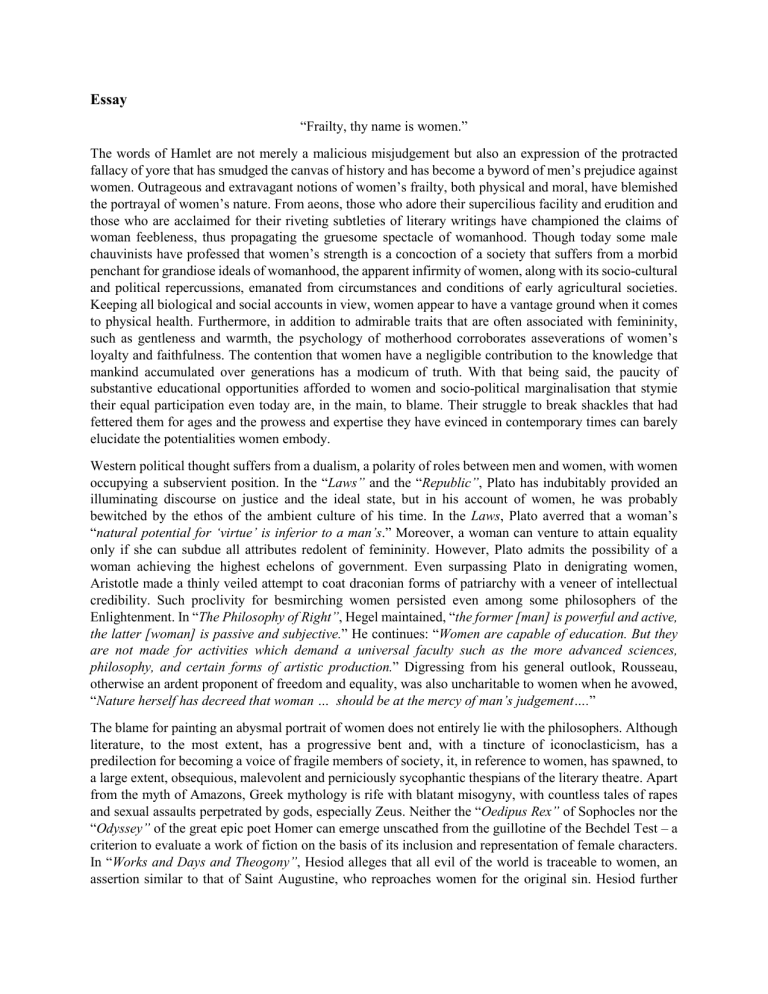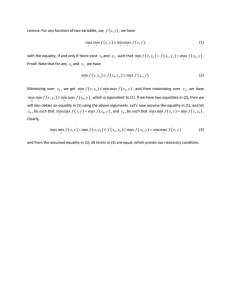Women's Roles & Strengths: A Historical & Biological Analysis
advertisement

Essay “Frailty, thy name is women.” The words of Hamlet are not merely a malicious misjudgement but also an expression of the protracted fallacy of yore that has smudged the canvas of history and has become a byword of men’s prejudice against women. Outrageous and extravagant notions of women’s frailty, both physical and moral, have blemished the portrayal of women’s nature. From aeons, those who adore their supercilious facility and erudition and those who are acclaimed for their riveting subtleties of literary writings have championed the claims of woman feebleness, thus propagating the gruesome spectacle of womanhood. Though today some male chauvinists have professed that women’s strength is a concoction of a society that suffers from a morbid penchant for grandiose ideals of womanhood, the apparent infirmity of women, along with its socio-cultural and political repercussions, emanated from circumstances and conditions of early agricultural societies. Keeping all biological and social accounts in view, women appear to have a vantage ground when it comes to physical health. Furthermore, in addition to admirable traits that are often associated with femininity, such as gentleness and warmth, the psychology of motherhood corroborates asseverations of women’s loyalty and faithfulness. The contention that women have a negligible contribution to the knowledge that mankind accumulated over generations has a modicum of truth. With that being said, the paucity of substantive educational opportunities afforded to women and socio-political marginalisation that stymie their equal participation even today are, in the main, to blame. Their struggle to break shackles that had fettered them for ages and the prowess and expertise they have evinced in contemporary times can barely elucidate the potentialities women embody. Western political thought suffers from a dualism, a polarity of roles between men and women, with women occupying a subservient position. In the “Laws” and the “Republic”, Plato has indubitably provided an illuminating discourse on justice and the ideal state, but in his account of women, he was probably bewitched by the ethos of the ambient culture of his time. In the Laws, Plato averred that a woman’s “natural potential for ‘virtue’ is inferior to a man’s.” Moreover, a woman can venture to attain equality only if she can subdue all attributes redolent of femininity. However, Plato admits the possibility of a woman achieving the highest echelons of government. Even surpassing Plato in denigrating women, Aristotle made a thinly veiled attempt to coat draconian forms of patriarchy with a veneer of intellectual credibility. Such proclivity for besmirching women persisted even among some philosophers of the Enlightenment. In “The Philosophy of Right”, Hegel maintained, “the former [man] is powerful and active, the latter [woman] is passive and subjective.” He continues: “Women are capable of education. But they are not made for activities which demand a universal faculty such as the more advanced sciences, philosophy, and certain forms of artistic production.” Digressing from his general outlook, Rousseau, otherwise an ardent proponent of freedom and equality, was also uncharitable to women when he avowed, “Nature herself has decreed that woman … should be at the mercy of man’s judgement….” The blame for painting an abysmal portrait of women does not entirely lie with the philosophers. Although literature, to the most extent, has a progressive bent and, with a tincture of iconoclasticism, has a predilection for becoming a voice of fragile members of society, it, in reference to women, has spawned, to a large extent, obsequious, malevolent and perniciously sycophantic thespians of the literary theatre. Apart from the myth of Amazons, Greek mythology is rife with blatant misogyny, with countless tales of rapes and sexual assaults perpetrated by gods, especially Zeus. Neither the “Oedipus Rex” of Sophocles nor the “Odyssey” of the great epic poet Homer can emerge unscathed from the guillotine of the Bechdel Test – a criterion to evaluate a work of fiction on the basis of its inclusion and representation of female characters. In “Works and Days and Theogony”, Hesiod alleges that all evil of the world is traceable to women, an assertion similar to that of Saint Augustine, who reproaches women for the original sin. Hesiod further admonishes, “Do not let any flattering woman beguile your good sense with the fascination of her shape. It’s your barn she’s after.” The offence of Shakespeare may be extenuated on account that he was chanting the score of his age and was mirroring the motif of the time. Nonetheless, women in his works are depicted to have questionable morals, especially those who are in power or have the lust for power, be it Lady Macbeth or Gertrude of Hamlet. By and large, the Renaissance, a fervent period of European cultural, artistic, political and economic “rebirth”, did not afford an appreciable latitude to women; they were esteemed if they were austere, unseen, and virtuous. In “The Taming of the Shrew” by Shakespeare, Katherine is an epitome of a “shrew”, a derogatory expression for women typical of the Renaissance. It is the age of reason, the Enlightenment, which gave rise to our cherished notions of equality, democracy and freedom. It was the time when women set forth to unveil the potentialities they possessed and to vouchsafe the world the glimpse of their genius. Consequently, the literature began to embrace the egalitarian ethos of the Enlightenment. Jane Austen’s Pride and Prejudice, Elizabeth Gaskell’s Wives and Daughters and George Eliot’s The Mill on the Floss feature comparatively vibrant, dauntless, indomitable and sagacious female characters. The eyes of the artless and naïve may be deluded by the apparent physical fragility of women. Nevertheless, on nearly all parameters of biological health, women have outscored men markedly, unmasking the flamboyance of their muscularity. Women have a longer life expectancy than men; the average lifespan is about five years longer for women than men in the U.S. and about seven years longer worldwide. The longevity database at the Department of Biology of the University of Alabama shows that all over the world and as far back as records have been kept, women outlive men by around five or six years. In addition, according to the Gerontology Research Group, around 43 people over the world are known to be living past the age of 110 and surprisingly, out of these supercentenarians, 42 are women. Also, there appear to be sex differences in immune responses to infections. Across all the different types of infections, the rate of progression of the disease for women is considerably lower than for men. Further, even though women are often maligned for their assumed temperamental nature and emotional sensitivity, the dispositions associated with diseases of high blood pressure, the age of onset of hypertension also occurs much earlier in men than women. Surely, more women around the world are in ill health than men, but it has to do with the fact that these women have survived events that would have brought death to men. Apologists for male chauvinism rebut that the studies proving the robustness of females often turn a blind eye to two important phenomena: one sociological and one behavioural. They argue that much of the difference in measures of life expectancy is attributable to the disparity in risk-taking behaviour between men and women. The Male Idiotic Theory (MIT), which is probably a satirical misnomer, stipulates that the reason men have a lower life expectancy and are more prone to injury and death is that they “are idiots and idiots do stupid things.” The theory posits that men are driven to take ridiculous risks for no defensible reason despite the clear prospects for self-harm. Another similar phenomenon is the young male syndrome – the propensity of males in their youth to engage in violent altercations to resolve seemingly trivial matters, to “save face,” to harm a rival, or otherwise to enhance their social status. In both humans and mammals, evolution seems to modulate such risk-taking and aggressive behaviours. From an evolutionary or functional point of view, aggressive behaviour is adaptive: it confers reproductive success. Reproductive success, in return, promotes the perpetuation of genes that control aggressive behaviour. Thus, risk-taking and aggressive behaviour are sexually selected. Another phenomenon may explain health differences in men and women. Sociological studies corroborate that women are much more likely than men to care about their health. Biologically, adaptive reproductive strategies that emphasise health and youth would suffice in explaining self-care differences. However, the raison d’etre is gender socialisation that has played a paramount role in moulding women into the matrix of established sexual narratives. In fact, about 80% of women surveyed admitted that doing something for themselves, such as savouring an aromatic bath, would make them feel relaxed and refreshed. Therefore, according to this perspective, women appear to be biologically stronger than men because they immoderately indulge in self-care and preening. Such gender differences in seeking healthcare also interpret the skewed sex distribution of health anxiety disorder or hypochondriasis – overwhelming fear of having a serious disease. But such arguments do not seem to hold water when records on gender variations in neonatal and early infant mortality are examined. For example, in a data set from India and Pakistan gathered between 2010 and 2018, the neonatal mortality rate was significantly higher in male infants (33.2/1,000 live births) compared to their female counterparts (27.4/1,000). The rates of stillbirths (31.0 vs 26.9/1000 births) and early neonatal mortality (27.1 vs 21.6/1000 live births) were also higher in males. Another study indicated that male twins had significantly greater odds of infant mortality and neonatal morbidity than their female co-twins. The situation is not much different in the rest of the world, and the global crisis of Covid-19 may provide an excellent synoptic view of it. Women were more vulnerable to coronavirus because the sectors hit hard by Covid-19 were women-dominated. Comprising roughly 70 per cent of the global health workforce, women make essential contributions as frontline responders and face particular vulnerabilities during emergencies like the COVID-19 pandemic. Regardless of the fact that Covid-19 has negatively affected many parameters of gender equality, it has killed more men than women in almost all regions of the world. In some countries, the mortality rate of men is almost double compared to that of women. The disparity in covid-related deaths has been explained by sex differences in genetic and biological makeup, with males being biologically weaker and more susceptible to diseases and premature death. Similar biological differences account for women outperforming men in ultra-endurance running. Women garner these awards partly because women have a greater distribution of slow-twitch muscle fibres, which are more resistant to fatigue, and partly because females use more emotion-focused coping than males. Women have not just proved themselves physically superior to men but also have evinced better management and leadership qualities. An analysis of 360-degree reviews shows that while the differences were not huge, women scored at a statistically significantly higher level than men on the vast majority of leadership competencies. Women excelled in indicators of (1) initiative-taking, (2) acting with resilience, (3) practising self-development, (4) driving for results, and (5) displaying high integrity and honesty. In fact, they were thought to be more effective in 84% of the competencies that are most frequently measured. Notably, respondents put greater importance on interpersonal skills, such as “inspires and motivates,” “communicates powerfully,” “collaboration/teamwork,” and “relationship building,” all of which women were rated higher. In contrast, men were rated as being better in two capabilities — “develops strategic perspective” and “technical or professional expertise”. One study found that outcomes related to Covid-19, including the number of cases and deaths, were systematically better in countries led by women. Another looked at governors in the U.S. and similarly found that states with female leaders had lower fatality rates. The gap between men and women in the pandemic is even larger than those in pre-pandemic, possibly signifying that women tend to perform better in a crisis. Women also tend to outshine men in the ethical landscapes of society. According to a cross-cultural study published in the journal Proceedings of the Royal Society B, women score consistently higher than men on moral dimensions of caring, fairness and purity. Carol Gilligan, a Harvard psychologist, suggested that men and women differ in how they solve moral dilemmas. Men see these problems in terms of justice, rules and individual rights. Women, on the other hand, tend to consider such issues in terms of relationships, caring and compassion. These differences are thought to be psychologically innate, as well as moulded by culture. Gender differences in moral codes are thought to have evolved to adapt to different roles – women as being caring and compassionate to protect offspring, for instance, or valuing purity to protect monogamous relationships. It is important for women to invest resources in creating and maintaining supportive social networks in order to protect themselves and their offspring. The fact that sex differences in the care factor drop markedly in collectivist cultures could be explained by higher ratios of men to women, thus accumulating sufficient evidence of women’s ascendancy in the ethical domain. Women’s paltry contribution to the knowledge of mankind, especially scientific development, can be explained on the ground that for most of history, educational opportunities awarded to women, if not minuscule, were not exhaustive, rendering women incapable of developing themselves. In particular, women were barred from pursuing STEM – science, technology, engineering, and mathematics disciplines. History has not done justice to women; those who dared to walk abreast of men were either fleeced of their intellectual opera and accolades or choked under the garb of custom and tradition. For instance, Emilie du Châtelet, a progenitor of Newtonian physics in France, is almost lost in the desert of history. Even today, gender stereotypes drive women’s carrier progression; women in STEM jobs are more inclined than men to say their gender has made it harder for them to succeed at work. Therefore, the seasoned and erudite may evince ignorance in assuming that women are nescient and philistine; in fact, they continuously face sociocultural and religious impediments that hinder their appropriate academic participation. Given that women’s natural potentials overshadow those of men, the question then arises of how preposterous conceptions of women’s fragility made their way to the society of today. Our modern picture of prehistoric societies, or what is often called the “standard narrative of prehistory”, looks a lot like The Flintstones, people living in nuclear families with men hunting and women, more or less, looking after the house and its dwellers. Conversely, the anthropologist Lewis Morgan, in his book Ancient Society, presented a model of a hunter-gatherer society in which men and women lived in general equality. Drawing on Morgan’s data, Friedrich Engels, in his book The Origin of Family, Private Property and the State, argued that prehistoric societies lived in what he called “primitive communism”, which anthropologists now call “fierce egalitarianism”. In addition to genealogical data collected from two hunter-gatherer populations, one in the Congo and one in the Philippines, the computer-simulated process of camp assortment also showed that sexual equality would have fostered wider-ranging social networks and closer cooperation between unrelated individuals, a requisite for the formation of large societies. Recently, Mark Dyble, an anthropologist at University College London, argued that it was only with the emergence of agriculture that inequality emerged. With the dawn of agriculture, people were able to accumulate resources for the first time. Men can start to have several wives, and they can have more children than women. Since women had to invest in such relationships to nurture children, they were mired in a zero-sum game which conspired inequality. In spite of considerable potential, women’s capabilities were and are shrouded by socio-political marginalisation and gender socialisation, which relegate women to an inferior position. For the most part of history, the socio-political lives of women were circumscribed, confining them to domestic drudgery. Being relatively more conspicuous in the political arena, the patriarchal norms and masculinity-based power relations engender gender-based social and political expectations, which largely delimit the role of each individual. Quite similar to the structural determinants that impede women’s political progress, the phrase “glass ceiling”, coined by Marilyn Loden, refers to an impalpable barrier that precludes certain individuals, especially women who venture to assume executive roles in a male-dominated corporate hierarchy, from being promoted to a higher stratum of an organisational setup. Politically suppressed women could not strive for equal rights in competitive markets and, consequently, were banished to modest zones of the economy. The non-availability of substantial employment opportunities, coupled with the patriarchal nature of society, plunges women into financial dependence on men. In addition, educational opportunities awarded to women, if not minuscule, are not exhaustive, rendering women incapable of developing themselves. As a result, women subjected to sexist attitudes are socialised to give in to trammels of misogynist order. Consequently, women indulge in self-policing and acquiesce to an unbroken spectrum of misogynistic violence. The cumulative effect of all these grievances is the widening of the gap between men and women as members of society. In the contemporary world, the changing nature of work that relies more on mental faculties than on muscular vigour and worldwide efforts to ensure equality of opportunity betoken auspicious prospects for women. The growing reliance on technology and the pivotal role of human capital in the world economy provide a cornucopia of opportunities for the progress and prosperity of women. In addition to developed countries of the world in which women are reaping the financial benefits of technology, women in conflict areas, from Afghanistan to Sudan, are also increasingly turning to technology to reduce gender inequality. Furthermore, in the countries of the world that are far ahead of others in achieving gender equality, the performance of women in sectors traditionally dominated by men is comparable to those of men. For example, in Nordic countries, it is more common for women to be enrolled in higher education institutions when compared to their male counterparts. Women surpassed men in educational attainment in Sweden in 2006 and in Finland in 2008. As a result, in these countries, there are comparatively high rates of female participation in the labour force and the proportion of parliamentary seats held by women. Consequently, stereotypes surrounding women are being shattered, producing a profound social change that paves the way for gender equality. The expression “Frailty, thy name is women” is a mortifying vestige of the history of mankind. Over the course of history, women have invariably been misrepresented and demeaned. Notwithstanding contrary claims, women have an enriched repertoire of commendable flairs. They have fecundity of mind and magnificence of character. They have an impeccable moral compass. They are as dauntless as Joan of Arc, as politic as Catherine the Great, as ingenious as Marie Curie, as resilient as Sojourner Truth and as unsurpassable as Fatima Jinnah. But, it is not a moment long gone when mankind appeared to appreciate the capabilities of women, and still, there is a long way to go. Failure in letting the true potential of women unfold may have protracted, but hope has not departed forever. A cross-national concerted onslaught seems imperative to mount the social-political barriers that hamper women’s ability to contribute and misconstrue their role in society. Along with women who are diligently working to ameliorate the perception of women, men also must join hands to let women throw off the shackles of gender stereotypes and break away from the manacles of gender discrimination. In this regard, a mature and constructive role of media and ample investment in educating not only women but also men will go a long way. Thus, a woman, if not loftier, is able to hold a candle to a man.



